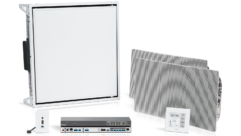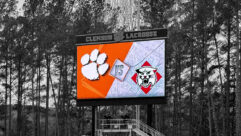Plasma Displays: new blood in the direct-view monitor market
Mar 1, 1998 12:00 PM,
Peter H. Putman
If you have kept up with the national magazines, newspapers, television andradio broadcasts, and trade publications, you have no doubt heard plentyabout the “new flat-screen displays” and “Buck Rodgers TV sets”-in otherwords, plasma displays. Perhaps you’ve even seen a few at CES, NAB,INFOCOMM, CEDIA, COMDEX, and other industry showcases. Plasma displays arecertainly generating a lot of press coverage and industry hype for theirdesign and feature sets, most notably their ability to produce large,bright images in boxes with less than 10 inches (254 mm) of depth. They dothis using a hybrid technology, combining the fixed pixel structure of aliquid-crystal display with tiny phosphors (similar to those used in CRTmonitors and projectors) excited by ionized gas discharges.
Plasma monitor sizes vary from 33 inches (838 mm) all the way to 50 inches(1.3 m) and are available in either 16:9 or 4:3 formats. There arecurrently four major players in the plasma market-Fujitsu, who OEMs a 16:940 inch (1 m) monitor to several companies; Mitsubishi, who has delayed thelaunch of its 4:3 Leonardo monitor until mid-1998; NEC, who offers a 4:3plasma display and has shown a 42 inch (1.1 m) 16:9 prototype, and Pioneer,who will be selling a 4:3 display.
The next waveAre these products the next wave in direct-view monitors? Will theysupplant conventional CRT technology or coexist with it? Given theavailable resolutions and price, the thinking here is that plasma has aways to go before it knocks other display technology off the hilltop. Forstarters, the maximum vertical resolution of any currently available plasmadisplay, whether 4:3 or 16:9, is only 480 lines. NEC and Pioneer both offer640 x 480 (VGA) resolution displays, while the 16:9 displays sold byFujitsu (and its OEM partners) and shown by NEC have an 852 x 480 pixelcount.
This means that a pixel interpolation system must be used to handle signalsat 800 x 600 (SVGA), 1,024 x 768 (XGA) and higher vertical resolutions.Because many of the plasma products available will handle SVGA, XGA andeven SXGA horizontal and vertical scan rates, high-resolution photographyand illustrations will translate over in an acceptable manner. However,small text and icons and the fine lines often found in workstation graphicswill probably drop out or break up.
The second limitation is one that plagues all flat-panel displays, whetherthey be LCD, DLP or plasma: their inability to generate deep, saturatedblacks in the picture, a problem caused by refraction and scattering oflight within the pixel structure. As a result, image grayscales arecompressed, lowering contrast ratios and resulting in pictures of less thanoptimal contrast. It is not as noticeable under high ambient lightinglevels (an area in which plasma displays excel), but the difference isclear when compared to a direct-view CRT monitor.
With these limitations, you’re probably wondering why anyone would replacea CRT direct-view with the equivalent plasma product, especially in view ofthe higher price tag that plasma carries. Well, one big reason is weight;33 inch (838 mm) 4:3 plasma monitors tip the scales around 60 to 70 pounds(27 to 32 kg), while a 40 inch (1 m) 16:9 display barely approaches 100pounds (45 kg). Contrast those numbers with 37 to 40 inch (940 mm to 1 m)direct-view CRT monitors at 200 to 270 pounds (90 to 122 kg). As Imentioned earlier, plasma monitors only require about five to eight inches(127 to 203 mm) of depth, 1/4 to 1/3 of the equivalent direct-view CRTmonitor.
>From an environmental standpoint, plasma monitors are very “green”. For alltheir light output, they have lower levels of electromagnetic emissionsthan CRTs, levels similar to those in LCD displays. This characteristicappeals to designers of kiosks and interactive displays where a viewer’snose might be parked only a couple of feet from the screen. Additionally,plasma displays consume much less power than a conventional direct-view CRTmonitor.
Carving a nicheManufacturing plasma displays with higher resolutions is a tricky businessat the present time. Unlike LCD panels, there is only one pixel sizeavailable, so increased resolution means larger panels with more weight.These are two technical issues being wrestled with by Pioneer and Fujitsubefore they start selling 50 inch (1.3 m) 1,024 x 768 resolution displaysto the general public. (Look for pre-production XGA plasma monitors to beshown at NAB ’98 and INFOCOMM ’98.)
As a result, plasma monitors will probably gain acceptance in applicationswhere composite/component video is viewed most of the time and space iseither at a premium or a flush-mount installation is desired. Advertisingkiosks, airport signboards, video conferencing rooms and home theater aresome of the first markets that will accommodate plasma. Classrooms andauditoriums displaying video, VGA- and SVGA-resolution graphics will alsobe able to put plasma to work, provided the price drops to a levelcomparable to direct-view monitors.
Here’s a trick that’s tough to do with conventional direct-view CRTmonitors: 16:9 plasma monitors have been successfully used in a vertical(portrait) orientation as dynamic signboards, cycling through still imagesand graphics while video plays on another horizontally oriented display. Aslong as we’re daydreaming here, plasma monitors could also be incorporatedinto an ultra-slim videowall with some rigging, taking up less than halfthe space required by CRT rear-projection cubes.
A place of their ownFor better or worse, plasma technology is being shipped and installed inapplications where an LCD/CRT projector or CRT direct view doesn’t alwaysfit the bill. If a customer wants a flat-screen TV, there’s not muchcompetition-neither LCD or DLP technologies can be adapted to makingcommercially available ultra-slim, larger-than-life displays. Sharp didshow a 40 inch (1 m) TFT display at COMDEX in 1996, accomplished bystitching together four 20 inch (508 mm) panels, but it isn’t currentlyslated for production.
The continued development of high-quality outboard video scaling engines,such as Snell & Wilcox’s Interpolator series, will help the plasma monitormarket. These devices work a lot harder than conventional pixel-mappingprocesses to interpolate lower and higher resolution signals to a plasmamonitor’s sweet spot (native resolution). The result is an image that hasmore of a grainy look that resembles film, as opposed to the pixelated lookso common to LCD and DLP projectors.
As usual, the key to increasing the demand for plasma will be expressed indollar signs. To paraphrase a popular film on baseball, “If you lower theprice, they will come.” Weight and size notwithstanding, CRT direct-viewmonitors are still considerably cheaper than their plasma cousins, offersuperior colorimetry and grayscale rendering, and require no external imagescaling or interpolation. It’s no surprise that two of the major players inthe direct-view market-NEC and Mitsubishi-have retained and even expandedtheir CRT offerings.










